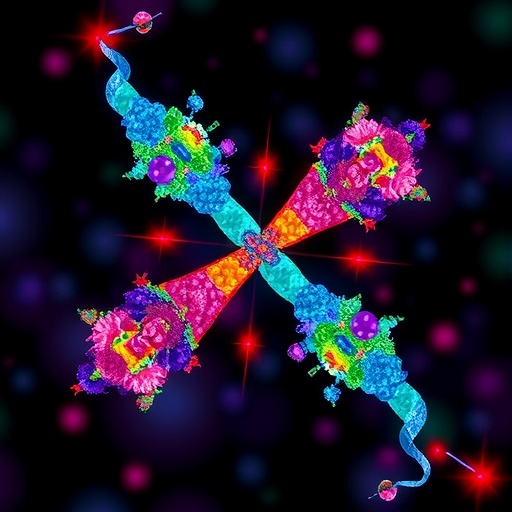In a groundbreaking advance at the intersection of computational design and molecular biophysics, researchers have harnessed the power of RFdiffusion alongside an innovative hypermutation system to engineer de novo single-domain antibodies, or VHHs, with atomically precise binding capabilities. This pioneering approach, described in a recent Nature publication, demonstrates not only the ability to target previously inaccessible viral and bacterial epitopes but also achieves marked improvements in binding affinity through in vivo evolution, setting the stage for transformative applications in therapeutic antibody design.
Central to this endeavor is the integration of RFdiffusion, a novel computational framework enabling the generation of VHH scaffolds designed specifically to engage elusive target epitopes with high specificity and structural fidelity. The authors embarked on targeting functionally critical epitopes on the virulence factor TcdB, the influenza H1 haemagglutinin, and the SARS-CoV-2 spike receptor-binding domain (RBD), molecules that have eluded traditional antibody generation efforts. From initial designs to experimentally validated complexes, this research paves the path for rapid and rational antibody generation against emergent pathogens.
A crucial bottleneck in antibody development has historically been the optimization of affinity, often requiring laborious rounds of in vitro evolution or selection. To circumvent this, the researchers utilized OrthoRep, an orthogonal error-prone DNA replication system that continuously induces hypermutation on target genes within yeast cells. OrthoRep facilitates accelerated affinity maturation in a live context, enabling the exploration of genetic space to refine antigen binding properties rapidly. This in vivo continuous diversification yielded affinity-matured variants with binding improvements of approximately two orders of magnitude compared to their parent designs, drastically enhancing their therapeutic potential.
The team applied this pipeline initially to VHHs targeting the receptor-binding domain of the C. difficile toxin B (TcdB), focusing on its Frizzled-binding epitope, a domain integral to host cell receptor engagement. Cryo-electron microscopy (cryo-EM) structural characterization of the parental VHH, dubbed VHH_TcdB_H2, confirmed successful engagement with the intended epitope on the central delivery and receptor-binding domain (DRBD) of TcdB. Analysis of 2D and 3D classification maps revealed a heterogeneous mixture of TcdB particles, some bound and others unbound, illustrating the dynamic binding landscape.
In-depth 3D classification isolated multiple structural states, notably the extended bound conformation of TcdB harboring the VHH interaction. Refinement yielded a cryo-EM density map with 4.6 Å resolution, into which the computational design model was rigid-body docked. This alignment demonstrated exceptional concordance between the predicted structure and experimental data, validating the accuracy of RFdiffusion-based design strategies. The maintenance of native-like binding poses at this resolution heralded a significant triumph in the de novo design of antibody scaffolds.
To interrogate the impact of affinity maturation, the researchers next characterized an improved variant, VHH_TcdB_H2_ortho, generated through OrthoRep-driven hypermutation. Cryo-EM analysis revealed a markedly increased fraction of toxin particles bound by the matured antibody, commensurate with its elevated binding affinity. Structural refinement of this complex reached approximately 5.7 Å resolution, which, although slightly lower than the parental complex, was sufficient to confidently dock the VHH and confirm that the affinity gain did not perturb binding specificity or pose. Hence, affinity maturation preserved the functional interaction while enhancing therapeutic viability.
Extending this methodology to viral targets, the team focused on the SARS-CoV-2 spike protein’s receptor-binding domain, a dynamic structure alternating between ‘up’ and ‘down’ conformational states critical for viral entry. The affinity-matured VHH, named VHH_RBD_D4_ortho19, was designed to engage an epitope accessible only in the ‘up’ conformation. Cryo-EM data exhibited VHH occupancy exclusively in the ‘up’ RBD state, congruent with the design premise. However, intrinsic RBD flexibility introduced challenges for resolution, with global refinement yielding an average map resolution of 3.9 Å, but significant structural heterogeneity was evident.
Using symmetry expansion and targeted local refinement strategies, the resolution at the VHH-spike interface improved to a range enabling visualization of secondary structural elements and reliable rigid-body docking. Notably, the experimental binding mode deviated from the original design. The VHH predominantly engaged via its framework region instead of the designed paratope, closely aligning with retrospective predictions generated by AlphaFold3. This discrepancy underscored intrinsic difficulties in predicting dynamic antibody-antigen interactions purely in silico and was classified as a design failure despite correct epitope targeting, emphasizing the complexity of antigen engagement.
Collectively, this impressive body of work illustrates the transformative synergy between advanced computational design algorithms like RFdiffusion and powerful in vivo evolution tools exemplified by OrthoRep. De novo designed antibodies with high structural accuracy and specificity can be rapidly affinity matured to therapeutic levels, overcoming major bottlenecks in antibody development pipelines. The structural validation via high-resolution cryo-EM offers unprecedented insights into the fidelity of computational antigen targeting.
Beyond the immediate implications for antibody engineering, these innovations promise to revolutionize responses to emerging infectious diseases by enabling rapid generation of precisely tailored antiviral or antitoxin antibodies. The capacity to design and mature VHHs targeting cryptic and conformationally dynamic epitopes opens avenues for next-generation immunotherapeutics with enhanced breadth, potency, and manufacturability.
While challenges remain, notably in capturing conformational plasticity and predicting binding kinetics, the demonstrated success positions RFdiffusion and OrthoRep at the forefront of protein engineering strategies. Future efforts integrating deep learning advances, structural prediction refinements, and expanded hypermutation libraries could yield even more sophisticated molecular recognition elements, accelerating the translation of design concepts into clinical realities.
This study sets a landmark precedent that atomically accurate de novo antibody design, combined with continuous evolutionary optimization, is not only feasible but can be systematically deployed to produce functional molecules against critical human disease targets. The path from in silico design to high-affinity functional binder is increasingly shortened, heralding a new era of rational, structure-guided therapeutic discovery driven by sophisticated computational and synthetic biology tools.
Subject of Research: Atomically precise de novo design and affinity maturation of single-domain antibodies (VHHs) targeting bacterial and viral epitopes
Article Title: Atomically accurate de novo design of antibodies with RFdiffusion
Article References:
Bennett, N.R., Watson, J.L., Ragotte, R.J. et al. Atomically accurate de novo design of antibodies with RFdiffusion. Nature (2025). https://doi.org/10.1038/s41586-025-09721-5
Image Credits: AI Generated




